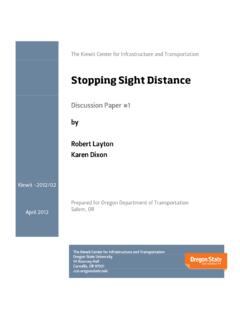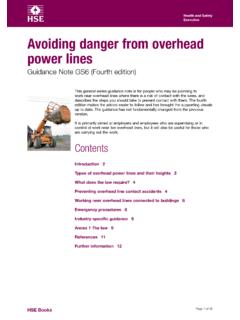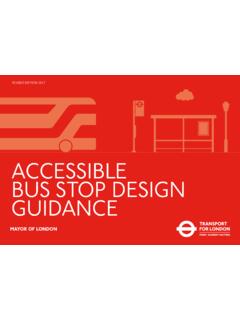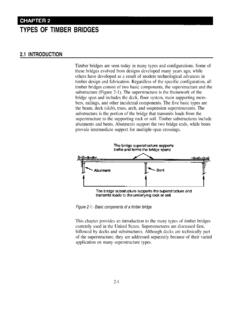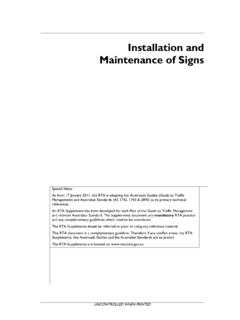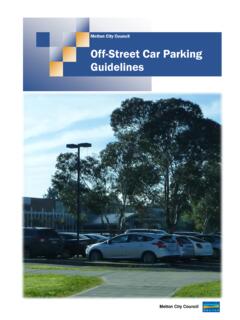Transcription of Collision Diagrams - Oregon State University
1 Collision Diagrams Collision Diagrams are used to display and identify similar accident patterns. They provide information on the type and number of accidents; including conditions such as time of day, day of week, climatic conditions, pavement conditions, and other information critical to determining the causes of safety problems. Accident reports should be organized by year of occurrence and accident type for the analysis period. Accidents that occurred after significant changes in highway or local land use should not be included. A. Construction of Collision Diagram Sketch the location diagram for either an intersection or roadway section using a standard form, such as, shown on the following page.
2 1. The sketch need not be to scale. 2. Show the path of each vehicle involved in the accident with adequate room for information. 3. Place a north arrow for orientation and any other descriptive information: a. Location identification b. Period of analysis c. Label the roads 4. Sketch the path of each vehicle to show vehicle maneuver, type of Collision and accident severity, and;. a. Time of day b. Day of week c. Date d. Lighting condition e. Pavement condition f. Other important information, , alcohol involvement Collision Diagrams -2- Permit Writers Workshop B. Symbols Symbols representing the nature of operation, vehicle or object involved and severity of the accident are adopted.
3 These are shown in the example Collision diagram on the following page. Symbols to represent types of collisions Diagrams are also standardized. C. Accident Patterns Accident patterns seen on the Collision diagram can often suggest possible accident problems. For example, a large number of angle accidents would imply the potential of a sight distance restriction. At the end of this set of notes is a set of Accident Pattern Tables which identify accident type, possible causes, possible studies to determine the problem, and possible countermeasures. Figures and Tables from Local Highway Safety Studies - User's Guide, USDOT-FHWA, 1986. Collision Diagrams -3- Permit Writers Workshop Collision Diagrams -4- Permit Writers Workshop Collision Diagrams -5- Permit Writers Workshop Table 1.
4 Accident Pattern Tables Accident Type Possible Cause Possible Study Safety Enhancement Roadside features Determine sideslope Provide traversable culvert and treatments Investigate recovery zone Extend culverts Install/improve traffic barriers Flatten slopes and ditches Relocate drainage facilities Overturn Inadequate shoulder Determine shoulder dimensions Upgrade shoulder surface and composition Remove curbing/obstructions Check for shoulder drop-offs Widen lane/shoulder Pavement feature Check for potholes and rutting Eliminate edge drop-off Check for water ponding Improve Superelevation/crown Obstruction in or too close to Field observation to locate Delineation / reflectorize safety hardware roadway obstructions Remove/relocate obstacles Install breakaway features to light poles, sign posts, etc.
5 Protect objects with guardrail Install crash cushions Inadequate lighting Check illumination Improve roadway lighting Inadequate pavement Review pavement markings Install reflectorized pavement lines/raised markers markings Inadequate signs, Review signs, delineators and Install reflectorized paint and/or reflectors on the fixed object Fixed Object delineators and guardrails guardrails Add special signing Upgrade barrier system Inadequate road design Check roadside shoulders and Install warning signs/delineators maintenance Improve alignment/upgrade Check Superelevation Proved proper Superelevation Perform ball-bank study Provide wider lanes Slipper surface Check skid resistance Reduce speed limit if justified by spot speed study Check for adequate drainage Provide adequate drainage Perform spot speed study Improve skid resistance Restricted sight distance Field observation for sight Install warning signs (see MUTCD).
6 Obstructions Install stop signs (see MUTCD). Check roadway illumination Install yield signs (see MUTCD). Perform spot speed study Restrict parking near corners Reduce speed limit if justified by spot speed study Right-Angle Remove sight obstructions Collisions at Install signals (see MUTCD). Unsignalized Install/improve street lighting Intersections Channelize intersections Large total intersection Volume count on all approaches Install signals (see MUTCD). volume High approach speed Perform spot speed study Reduce speed limit on approaches if justified by spot speed study Install rumble strips Poor visibility of signals Review existing signals and Install advanced warning devices (see MUTCD).
7 Placement Install visors Field observation for sight Install back plates obstructions Reduce speed limit on approaches if justified by spot speed Perform spot speed study study Remove sight obstructions Add additional signal heads Right-Angle Install 12-in. signal lenses (see MUTCD). Collisions at Improve location of signal heads Signalized Install overhead signals Intersections Inadequate signal timing Volume count on all approaches Adjust amber phase Review signal timing Provide all-red clearance phases Add multi-dial controller Install signal actuation Retime signals Provide progression through a set of signalized intersections Collision Diagrams -6- Permit Writers Workshop Table 1.
8 Accident Pattern Tables Accident Type Possible Cause Possible Study Safety Enhancement Pedestrian crossing Review pedestrian signing and Install/improve signing or marking of pedestrian crosswalks crosswalk marking Driver not aware of Review signing Install/improve warning signs intersection Slippery surface Check skid resistance Provide SLIPPERY WHEN WET' signs Rear-End Check for adequate drainage Reduce speed limit on approaches if justified by spot speed Collisions at Perform spot speed study study Unsignalized Provide adequate drainage Intersections Groove pavement Overlay pavement Large numbers of turning Perform turning count Prohibit turns vehicles Perform volume count for Increase curb radii through traffic Create left- or right-turn lanes Restricted sight distance Review sight distance Install advance warning signs (see MUTCD).
9 Remove sight obstructions Install train actuated signals (see MUTCD). Install gates (see MUTCD). Reduce grades Poor visibility Check roadway illumination Increase size of signs Collisions at Review signing Improve roadway lighting Railroad Inadequate pavement Review pavement markings Install advance markings to supplement signs Crossings markings Install stop bars Install/improve pavement markings Rough crossing angle Check crossing surface Improve crossing surface Sharp angle crossing Check crossing angle Rebuild crossing with proper angle Improper pre-emption timing Review traffic signal timing Retime traffic signals of traffic signals, railroad Review railroad signal and gate Retime railroad signals and gates signals.
10 Or gates timing Poor visibility or lighting Check roadway illumination Install advance warning signs (see MUTCD). Remove sight obstructions Install train actuated signals (see MUTCD). Install gates (see MUTCD). Reduce grades Poor visibility or lighting Check roadway illumination Install/improve warning signs Night-Time Install/improve delineation/markings Install/improve street lighting Poor sign quality Review signing Upgrade signing Provide illuminated reflectorized signs Inadequate channelization or Review Install pavement markings delineation channelization/delineation Improve channelization/delineation Slippery pavement Check skid resistance Provide SLIPPERY WHEN WET' signs Reduce speed limit if justified by spot speed study Provide adequate drainage Wet Groove existing pavement Pavement Overlay existing pavement Inadequate pavement Review pavement markings Install

